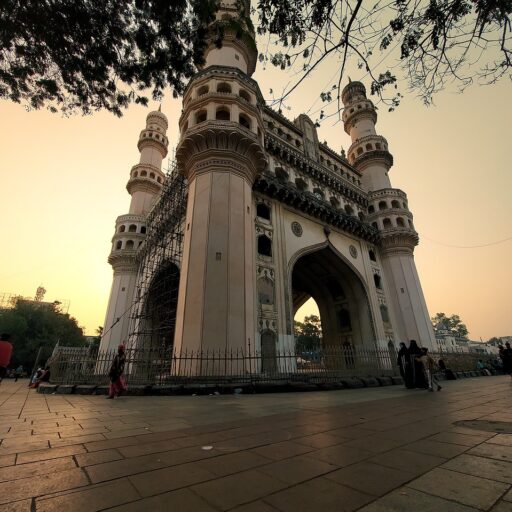CHARMINAR

The Charminar is one of the most iconic monuments in India, located in the city of Hyderabad, Telangana. It was constructed in 1591 by Sultan Muhammad Quli Qutb Shah, the fifth ruler of the Qutb Shahi dynasty. The monument is an impressive example of Indo-Islamic architecture, blending Persian, Mughal, and Hindu styles. It is named “Charminar,” meaning “four minarets,” as it features four grand minarets that stand at 48.7 meters (160 feet) tall.
The Charminar is situated at the intersection of the Laad Bazaar and the Macca Masjid, offering a view of the city’s bustling markets and streets. Its four minarets are adorned with intricate carvings and floral motifs. The structure has a square shape with each side measuring approximately 20 meters (66 feet).
The monument was initially built to commemorate the founding of Hyderabad and to celebrate the eradication of a plague that had ravaged the city. Legend has it that Sultan Muhammad Quli Qutb Shah prayed for the end of the plague and promised to build a mosque and monument if his wish was fulfilled. The Charminar stands as a symbol of the Sultan’s devotion to his people.
Each of the four arches of the Charminar opens to a different street, connecting various parts of the city. The arches are intricately designed with detailed stucco work and small domes. The central dome of the Charminar is crowned with a small pavilion, adding to the monument’s grandeur.
Charminar’s architecture reflects both Islamic and Hindu influences. The minarets are made from granite, and the structure is built using lime mortar. The design of the Charminar includes a blend of Persian-style arches, Islamic calligraphy, and Hindu decorative motifs.
Inside the Charminar, there is a small mosque located on the western side. The mosque is still active and is one of the oldest functioning mosques in Hyderabad. The monument’s design features an open terrace that offers a panoramic view of the city, including the nearby Macca Masjid and the bustling markets of the area.
The monument has become a major tourist attraction, drawing visitors from around the world. It is one of the most recognized landmarks of Hyderabad, along with other famous sites like the Golconda Fort and the Hussain Sagar Lake. Charminar is also part of the city’s cultural and historical identity, representing its rich heritage and traditions.
The Laad Bazaar, which surrounds the Charminar, is famous for its traditional jewelry, especially bangles made of glass, and other local handicrafts. This market has been in existence for centuries and continues to attract both locals and tourists.
Over the years, the Charminar has undergone several restoration and conservation projects to preserve its beauty and structural integrity. The monument has withstood the ravages of time and remains a testament to the architectural brilliance of the Qutb Shahi dynasty.
In addition to its historical and architectural significance, the Charminar is also an integral part of the cultural fabric of Hyderabad. It is often seen in various forms of art, literature, and media, symbolizing the city’s spirit and its rich cultural diversity.
The Charminar stands as a reminder of Hyderabad’s glorious past and continues to be a proud symbol of the city’s heritage. It has remained an enduring symbol of both the Qutb Shahi dynasty’s architectural legacy and the region’s vibrant history.
Golconda Fort
Golconda Fort, a historic and monumental structure, is located around 11 kilometers from the center of Hyderabad, India. It was originally built in the 13th century by the Kakatiya dynasty as a mud fort, but it was later expanded and renovated into its present form by the Qutb Shahi dynasty in the 16th century. The fort is situated atop a hill, offering a breathtaking view of the surrounding area.
Architectural Marvel: The fort features strong walls, intricate gateways, and majestic entrances. The walls of the fort stretch over 10 kilometers and stand up to 15 meters tall. The fort is also known for its advanced architectural design, including a unique acoustic system where a clap or sound at the main entrance can be heard clearly at the top of the hill, allowing it to serve as a warning mechanism.
Diamond Trade: Golconda Fort was historically famous for its diamond mines, particularly during the Qutb Shahi era. The region was known as the “diamond hub,” and it was here that some of the world’s most famous diamonds, like the Koh-i-Noor, were mined.
Breathtaking Views: The fort offers panoramic views of Hyderabad and the surrounding areas, especially from the top. The climb up to the fort is steep, but once you reach the top, you are rewarded with stunning vistas.
Water Supply System: The fort’s water management system is impressive, with reservoirs, water tanks, and an elaborate underground tunnel system that once provided water to the fort during sieges.
Palaces and Structures: Within the fort, there are many notable structures, including the ancient royal palaces, halls, mosques, and gardens. The sound and light show held in the evenings adds a mystical charm, bringing the history of the fort to life.
Historical Significance: The fort played a central role in the history of Hyderabad, serving as the capital of the Qutb Shahi dynasty from the 16th century until the Mughal conquest in 1687.
Golconda Fort remains a testament to India’s rich history and is one of the most iconic landmarks in Hyderabad. It’s a must-visit for history buffs, architecture enthusiasts, and anyone looking to explore the deep cultural heritage of India.


